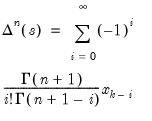Name | Function | Description |
@bridge(s) | imputes NAs in s. | Returns a copy of series s with NAs replaced by the nearest preceding non-NA value. This function is panel aware. |
d(x) | first difference |  where  is the lag operator. is the lag operator. |
d(x,n) | n-th order difference |  . . |
d(x,n,s) | n-th order difference with a seasonal difference at  |  . . |
dlog(x) | first difference of the logarithm |  . . |
dlog(x,n) | n-th order difference of the logarithm |  . . |
dlog(x,n,s) | n-th order difference of the logarithm with a seasonal difference at  |  . . |
@demean(s[, smpl]) | demean | Returns a copy of series s translated to have a mean of zero. |
@demeanby(s, g[, smpl]) | demean by group | Returns a copy of series s translated to have a mean of zero within each group of observations defined by series g. |
@detrend(s[, smpl]) | detrend | Returns the residuals of an OLS regression on series s versus an implicit time trend. This function is panel aware. |
@fracdiff(s, n) | returns  for series s (see description). This function is panel aware. for series s (see description). This function is panel aware. | Fractional difference operator: For  , ,  |
@lag(x, n) | n-th order lag (equivalent to “X(‑4”) for the series X) |  |
@pc(x) | one-period percentage change (in percent) | equals @pch(x)*100 |
@pch(x) | one-period percentage change (in decimal) |  . . |
@pca(x) | one-period percentage change—annualized (in percent) | equals @pcha(x)*100 |
@pcha(x) | one-period percentage change—annualized (in decimal) |  where  is the lag associated with one-year ( is the lag associated with one-year ( ) for quarterly data, etc.). ) for quarterly data, etc.). |
@pcy(x) | one-year percentage change (in percent) | equals @pchy(x)*100 |
@pchy(x) | one-year percentage change (in decimal) |  , where , where  is the lag associated with one-year ( is the lag associated with one-year ( ) for annual data, etc.). ) for annual data, etc.). |
@periodtodate(s, p[, smpl]) | period-to-date of series s. | Cumulative sum of series s within each period, where each period is defined by a contiguous block of identical values in series p. |
@ytd(s[, smpl]) | YTD of series s. | Provides the cumulative sum of a series within the year. Optionally, a sample may be provided to limit the observations included in the summation. |